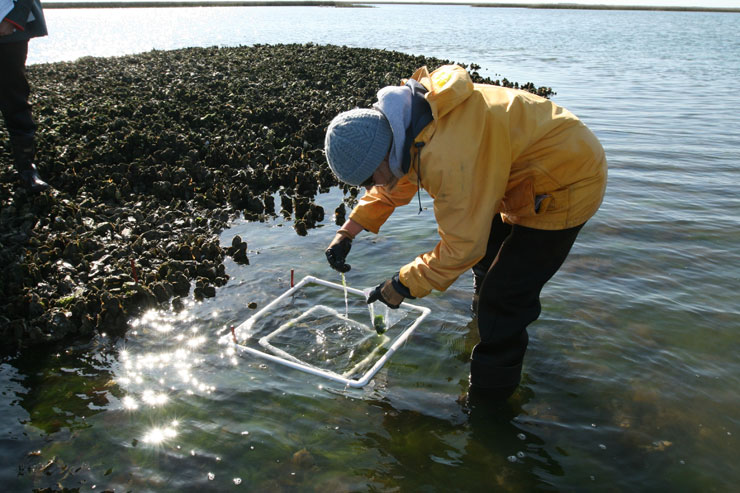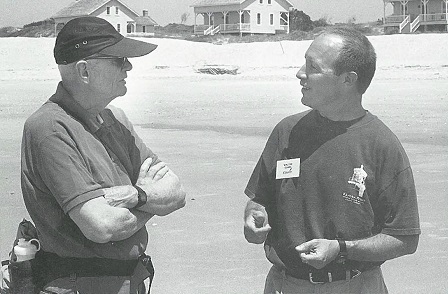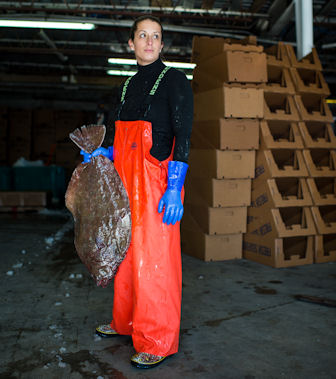SEA SCIENCE: Network Connects Students to Algae Research

Leaning over a pier railing, First Flight High School student Lauren Nelson lowers a plankton net almost 26 feet into the ocean.
Nelson drags the net across the water for three minutes and then pulls her catch onto the U.S. Army Corps of Engineers Field Research Facility pier in Duck. She squeezes the water out of the plankton net, then puts it into the sample bottle.
“I have learned what plankton do,” Nelson says. “It is exciting to find harmful algal blooms and something that can have such an effect on our lives. I didn’t realize the toxicity of harmful algal blooms.”
Each week. Nelson and other volunteers from First Flight in Kill Devil Hills collect a sample of phytoplankton, single-cell organisms that drift in the ocean. Using a net, thermometer and salt refractometer, the group also looks for harmful algal blooms or “HABs” that include single-celled, microscopic algae.
The teen researchers, known as “Phytofinders,” are part of the Southeast Phytoplankton Monitoring Network (SEPMN) that monitors HABs. Some harmful algae produce toxins that become concentrated in shellfish and accumulate in marine animals, potentially leading to the closure of shellfish harvesting and mortalities in a variety of marine species, including fish, sea turtles, dolphins and whales.
“This is one of the few groups in the monitoring network that collects samples from an open ocean site,” says Jeff Paternoster, outreach specialist for SEPMN. “Most of the other groups collect samples in estuaries.”
The live samples are taken to the school lab where students look at them under microscopes. The samples then are sent to the National Oceanic & Atmospheric Administration’s (NOAA) Marine Biotoxins Program in Charleston, S.C.
N.C. MONITORING
In North Carolina, Terri Kirby Hathaway of North Carolina Sea Grant serves as the network’s liaison.
Hathaway started with eight teachers and sites in Dare, Carteret and New Hanover counties and later added a site in Hyde County. The newest site is in Brunswick County.
“We currently have 13 trained teachers in North Carolina,” Hathaway says. “We hope to incorporate additional sampling sites in the future. It has been exciting to watch the students — and see how it finally dawns on them that they are actually doing scientific research and contributing to the overall knowledge of North Carolina’s coastal waters and habitats.”
Katie Neller of First Flight says her students benefit from working with scientists.
“They learn about real-world applications,” says Neller, a biology and environmental science teacher.
“Since it is all volunteers and not a class project, it builds a strong camaraderie.”
TOXIC BLOOMS
Through the SEPMN, volunteers from schools and the community are alerting coastal managers to potential HAB hazards.
In November, volunteers from First Flight and the College of the Albemarle identified the first toxic Pseudo-nitzchiapungens and Pseudo-nitzschia multiseries blooms in North Carolina waters.
“No scientists had ever found these species in this part of the Atlantic,” Paternoster says. The domoic acid — a toxin produced by an ocean algae invisible to the naked eye — can move up the food chain and harm sea life and possibly humans.
A human health syndrome, Amnesic Shellfish Poisoning (ASP), can be caused by consuming tainted shellfish, Paternoster adds. “However, the North Carolina domoic acid toxicity levels in sampled oysters were very low, about 3,000 times less than the regulatory limits.”
This year, more than 60 SEPMN volunteer groups will be monitoring 72 sites along the southeast Atlantic coast from the northern Outer Banks in North Carolina to Jacksonville, Fla. Volunteers include middle school, high school and college students, as well as community groups, master gardeners and others.
Data gathered by volunteers are transferred to state resource managers as an early warning of possible HAB events. The observations also help scientists develop an up-to-date list of phytoplankton species found along the southeastern coast.
“This program truly connects very sophisticated research about algae and toxins to students,” says Lundie Spence, director of the Center for Ocean Sciences Education Excellence SouthEast in Charleston. “It underscores the importance of local knowledge and observations.”
Research oceanographer Steve Morton established the network in 2001 after taking a position at the Marine Biotoxins Program.
“I noticed that there was no distribution information on plankton in South Carolina,” says Morton. “Before coming to NOAA, I worked at the Bigelow Laboratory for Ocean Sciences in Maine where they had started a phytoplankton network to identify the toxic species Alexandrium. I knew the methods worked on one species.”
He decided to start a network in South Carolina that included several HABs and phytoplankton species.
HAB EVENTS
“Harmful algal blooms present one of the most scientifically complex and economically significant coastal management issues facing the nation today,” according to the NOAA Center for Sponsored Coastal Ocean Research.
In the past, only a few regions of the United States were affected by HABs, but now all U.S. coastal regions have reported major blooms.
HABs have decimated the scallop fishery in Long Island’s estuaries and led to seasonal closures of various shell fisheries along the Atlantic, Gulf of Mexico and Pacific coasts, according to the NOAA report.
During the last eight years, researchers have seen an explosion of domoic acid poisoning in pelicans and other sea creatures along the California coast.
Scientists believe a pelican that crashed through a car in Los Angeles last year was probably infected with domoic acid, according to a CBS News report.
And the famous Alfred Hitchcock movie “The Birds” — where thousands of seabirds invade Northern California — was based on a real incident near Santa Cruz, Calif., in 1961, that may have been caused by domoic acid.
In North Carolina, HABs have been found in both fresh and salt water. Blue-green algae or cyanobacteria flourish in lakes and ponds with poor water quality, especially during the summer. The algae can cause skin or respiratory irritations in people who drink the untreated water.
The N.C. Public Water Supply Section monitors public drinking water supplies to ensure safe drinking water.
From 1986 to 2006, there were 83 fish kills in North Carolina waters, according to the N.C. Division of Water Quality, which monitors non-drinking water. More than 40 of the kills occurred in eastern North Carolina. State officials suspect that algal blooms may have been the cause.
SEPMN OUTREACH
Each year, SEPMN staff members teach more than 3,000 students and community members about the role of phytoplankton in the marine ecosystem, how to identify phytoplankton and the impacts of HABs and their toxins.
This year, Paternoster worked with an earth science class at the Dare County Alternative School for at-risk students in Manteo.
After he presented an overview of the program, the students used a digital microscope to look at live plankton samples collected from the Atlantic Ocean.
“We are only counting the live samples because the dead ones no longer reproduce,” explains Paternoster.
Earth science teacher Ashley Bahen says her students got excited about the presentation. “This is the first time that my students have used a microscope this year,” Bahen adds. “They don’t have that much chance to do hands-on activities.”
Ninth grader Eric Dieck agrees. “This is great,” says Dieck. “I want to be a volunteer and get some samples.”
The SEPMN staff plans to reach more students and other potential volunteers by expanding the network to include the Gulf Coast, Massachusetts and Alaska.
“We are here to educate the public about harmful algal blooms,” Paternoster says. “One of the best ways to do this is by reaching students who then go home and talk about it with their parents. The volunteer observations also help broaden research efforts by state and federal laboratories.”
To find out more about the Southeast Phytoplankton Monitoring Network, visit the Web: http://marex.uga.edu/southeast_phytoplankton_monitoring_network/.
For more information about North Carolina network training sessions, contact Terri Kirby Hathaway, terrikh@csi.northcarolina.edu.
PHYTOPLANKTON FACTS:
- Main types of phytoplankton: diatoms, dinoflagellates and blue-green algae
- Found in marine, freshwater and soil environments
- Some undergo photosynthesis
- Benefits:
- Start of marine food web
- Part of global carbon cycle
- Source of oxygen
- Source of many natural products
- Good indictor of environmental change
This article was published in the Early Summer 2007 issue of Coastwatch.
For contact information and reprint requests, visit ncseagrant.ncsu.edu/coastwatch/contact/.
- Categories:


